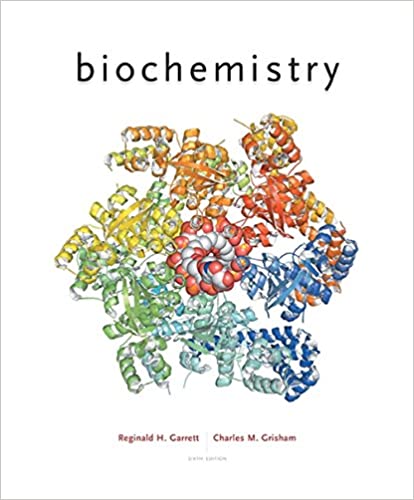
Biochemistry 6th Edition by Reginald Garrett,Charles Grisham
Edition 6ISBN: 978-1305577206
Biochemistry 6th Edition by Reginald Garrett,Charles Grisham
Edition 6ISBN: 978-1305577206 Exercise 15
The effect of the accumulation of P, the reaction product, on the Michaelis-Menten equation
Equation 13.9 presents the simple Michaelis-Menten situation where the reaction is considered to be irreversible ([P] is negligible). Many enzymatic reactions are reversible, and P does accumulate.
a. Derive an equation for v, the rate of the enzyme-catalyzed reaction S ? P in terms of a modified Michaelis-Menten model that incorporates the reverse reaction that will occur in the presence of product, P.
b. Solve this modified Michaelis-Menten equation for the special situation when v = 0 (that is,
![The effect of the accumulation of P, the reaction product, on the Michaelis-Menten equation Equation 13.9 presents the simple Michaelis-Menten situation where the reaction is considered to be irreversible ([P] is negligible). Many enzymatic reactions are reversible, and P does accumulate. a. Derive an equation for v, the rate of the enzyme-catalyzed reaction S ? P in terms of a modified Michaelis-Menten model that incorporates the reverse reaction that will occur in the presence of product, P. b. Solve this modified Michaelis-Menten equation for the special situation when v = 0 (that is, is at equilibrium, or in other words, Keq = [P]/[S]). (J. B. S. Haldane first described this reversible Michaelis-Menten modification, and his expression for Keq in terms of the modified M-M equation is known as the Haldane relationship.)](https://storage.examlex.com/SM1109/11eb6c64_c380_5942_bdca_816418bc2293_SM1109_00.jpg) is at equilibrium, or in other words, Keq = [P]/[S]). (J. B. S. Haldane first described this reversible Michaelis-Menten modification, and his expression for Keq in terms of the modified M-M equation is known as the Haldane relationship.)
is at equilibrium, or in other words, Keq = [P]/[S]). (J. B. S. Haldane first described this reversible Michaelis-Menten modification, and his expression for Keq in terms of the modified M-M equation is known as the Haldane relationship.)
Equation 13.9 presents the simple Michaelis-Menten situation where the reaction is considered to be irreversible ([P] is negligible). Many enzymatic reactions are reversible, and P does accumulate.
a. Derive an equation for v, the rate of the enzyme-catalyzed reaction S ? P in terms of a modified Michaelis-Menten model that incorporates the reverse reaction that will occur in the presence of product, P.
b. Solve this modified Michaelis-Menten equation for the special situation when v = 0 (that is,
![The effect of the accumulation of P, the reaction product, on the Michaelis-Menten equation Equation 13.9 presents the simple Michaelis-Menten situation where the reaction is considered to be irreversible ([P] is negligible). Many enzymatic reactions are reversible, and P does accumulate. a. Derive an equation for v, the rate of the enzyme-catalyzed reaction S ? P in terms of a modified Michaelis-Menten model that incorporates the reverse reaction that will occur in the presence of product, P. b. Solve this modified Michaelis-Menten equation for the special situation when v = 0 (that is, is at equilibrium, or in other words, Keq = [P]/[S]). (J. B. S. Haldane first described this reversible Michaelis-Menten modification, and his expression for Keq in terms of the modified M-M equation is known as the Haldane relationship.)](https://storage.examlex.com/SM1109/11eb6c64_c380_5942_bdca_816418bc2293_SM1109_00.jpg) is at equilibrium, or in other words, Keq = [P]/[S]). (J. B. S. Haldane first described this reversible Michaelis-Menten modification, and his expression for Keq in terms of the modified M-M equation is known as the Haldane relationship.)
is at equilibrium, or in other words, Keq = [P]/[S]). (J. B. S. Haldane first described this reversible Michaelis-Menten modification, and his expression for Keq in terms of the modified M-M equation is known as the Haldane relationship.)Explanation
a. The simple Michaelis-Menten equation ...
Biochemistry 6th Edition by Reginald Garrett,Charles Grisham
Why don’t you like this exercise?
Other Minimum 8 character and maximum 255 character
Character 255


